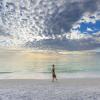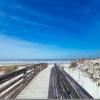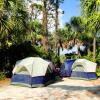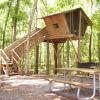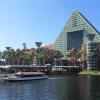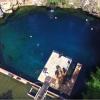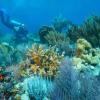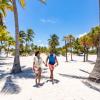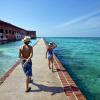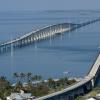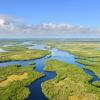Florida's Intracoastal Waterway offers sailing, cultural diversions, historic experiences at its ports of call.
Florida's Intracoastal Waterway system runs along the Sunshine State, providing boaters with extraordinary ports of call. Slip into any of these magical watercourses and you'll be immersed in a natural world, large sections of which resemble what the Spanish explorers first witnessed. Wildlife abounds on these ever changing shorelines, with mangrove islands and cedar lined sloughs in the south, and wind sculpted oaks and expansive cord grass marshes along the northern reaches.
These Florida ports of call are interspersed with "Old Florida" fishing ports, historic harbors and modern cities, providing mariners conveniences the first explorers could never have imagined.
Contemporary marinas with rows of gleaming yachts are less than a day's sail away from exquisite solitude, world-class fishing and funky destinations to delight the laid back bohemian. Take your boat around the state, or just drop it in the water at one of the waterways' many access points. It's an adventure that will last a lifetime.
ISLAND ESCAPES
The Intracoastal Waterway from Fort Myers to Longboat Key is a favorite destination for visiting sailors and fishermen alike. The waters from Fort Myers through Pine Island Sound and Charlotte Harbor have to be one of the most diverse boating and fishing locations in Florida. Pine Island Sound is bounded on the west by Sanibel, Captiva and North Captiva Islands. Hundreds of islands dot the Sound; redfish, snook, pompano and speckled trout delight the patient angler. To the east, Pine Island's mangrove shorelines, tidal creeks and oyster bars still resist the crush of development. Explore Matlacha, Pineland and Bokeelia for a taste of the real Florida, where Calusa Indians farmed and fished more than 1,000 years ago.
Sanibel, a thriving and upscale resort island, has a reputation as one of the world's best shelling locations, and the Ding Darling National Wildlife Refuge is one of the top birding destinations anywhere. Eclectic Captiva is home to multi-million dollar mansions, the exclusive South Seas Island Resort and wonderful old Florida lodging at Jensen's Twin Palm Cottages & Marina. Explore the beaches or take to the bay and enjoy lunch on historic Cabbage Key.
Further north in Charlotte Harbor sits Cayo Costa State Park, a spectacular wild and scenic gulf coast island accessible only by boat. Nature trails, safe harbors, cabins, tent sites, hiking and biking trails and miles of deserted beaches make this a must-see location. The Intracoastal runs along the eastern shore of Cayo Costa before heading inland at Boca Grande Pass, "Tarpon Capital of the World." Boca Grande, with its quaint small town main street, tree canopied roads and white clapboard houses, is on the northern end of Gasparilla Island. This low-key destination is a playground of presidents.
CULTURAL DIVERSIONS
From Gasparilla Island, the waterway skirts the eastern shore of a string of barrier islands interspersed with housing developments that populate the fringes of the coastal marshes. The next port of call is Venice, known as the "Shark Tooth Capital of the World." Walk the beaches of this quiet, unassuming town and you'll see people bent over in pursuit of the small, shiny black teeth.
Just a few miles to the north is Sarasota, a mecca of sparkling white sand beaches, museums and cultural delights like Marie Selby Botanical Gardens, the Ringling Museum of Art and the Historic Asolo Theatre. It's possible to enjoy all that the area has to offer from the waterway, which runs less than a quarter mile from downtown and gives boaters access to the Gulf beaches through New Pass and Big Pass. When you visit the area don't miss a sailing or fishing trip in Sarasota Bay, one of the state's loveliest and most forgiving bodies of water.
SOUTH FLORIDA SAILING
The Florida east coast city of Fort Lauderdale is 200 miles away by land, but a world apart in other ways. Here miles of the Intracoastal intersect a city of high-rise condominiums, hotels and commercial establishments. Fort Lauderdale port of call is also crisscrossed with canals and residential developments with untold numbers of luxury yachts, pleasure crafts, fishing boats and dive vessels. Fort Lauderdale alone has more than 60 marinas, many of which have accommodations for transients and repair services for their vessels. The waterway from Fort Lauderdale south through Dania, and Hollywood to Miami, is rather straightforward although crowded, providing boaters many access points and numerous shopping and dining venues.
If you're looking for a port of call in Miami, you'll have many options, but there are a couple of destinations that shouldn't be missed. South Beach, where Art Deco reigns supreme, can be reached by short walk from Miami Beach Marina. Another destination for the boater is Coconut Grove. Docking at the Dinner Key Marina gives you easy access to the Grove, where you'll find a plethora of trendy art galleries, and the best restaurants and night clubs in Florida.
Heading south from Miami to Key Largo, enter the strikingly different world of Biscayne Bay and Biscayne National Park. Biscayne Bay is one of the world's best destinations for anglers wanting to fish for elusive permit and bonefish, as well as the mighty tarpon.
At the southern end of this section of the Intracoastal sailors pass through Card Sound before reaching Key Largo, the first island in the famous Florida Keys chain. The largest of the Keys, Key Largo is famous for its diving and fishing. John Pennekamp Coral Reef State Park, the nation's first underwater park, is the crown jewel of the area.
No trip to the Keys would be complete without experiencing the backcountry of Florida Bay, and the extensive flats that border the Atlantic Ocean.
THE FIRST COAST
The waterways of northeast Florida have a much different feel than those to the south. Ports of call in northeast Florida have unique places to visit as St. Augustine, the nation's oldest continuously occupied city, first visited by Ponce de Leon in 1513.
The Intracoastal Waterway in St. Augustine offers a wide variety of opportunities for boaters. You can launch at a number of local ramps and explore myriad creeks that meander into the marshes. Here you'll find a plethora of bird life, while beneath the waters, mullet, sheepshead and redfish dart from submerged oyster bars. On calm days, head out Matanzas Inlet for a chance at bluefish, mackerel, tuna, grouper and snapper in the Atlantic Ocean. Cruising along the waterway will also afford you a unique view of the old city, including the mighty Castillo de San Marcos.
Distinctive accommodations abound, like the charming and historic St. Francis Inn. Dating from 1791, St. Francis is the city's oldest inn and features a lovely courtyard entrance, attractive rooms and a wonderful homemade breakfast.
To the north of St. Augustine is Guana Tolomato Matanzas National Estuarine Research Reserve (GTM Reserve), located on a barrier island between St. Augustine and Jacksonville. Ancient middens (shell mounds) contain an early 19th century Minorcan coquina block well. In addition to its rich history, the GTM Reserve provides a host of activities including fishing, birding, hiking and biking on nine miles of nature trails. There's also a small chance of seeing northern right whales and three species of sea turtles on Florida Atlantic beaches.
The metropolitan city of Jacksonville is located less than an hour to the north, and is a short side trip for cruisers on the waterway. There you can have access to a vibrant waterfront, which has a score of restaurants, bars and shopping venues.
No trip to the northeast coast of Florida would be complete without a visit to Fernandina Beach on Amelia Island, where you'll find un-crowded beaches, a historic fort and winding roads shaded by moss-covered oaks. A wealth of accommodations awaits the visitor on Amelia Island, from funky beach houses to the exclusive Omni Amelia Island Resort. The Nantucket-style Elizabeth Pointe Lodge, with well-appointed room, peaceful porch and never-empty cookie jar, is located on the beach with an expansive view of the Atlantic.
A short ride away is historic downtown Fernandina Beach, which sits right on the Intracoastal. Its full service municipal marina provides excellent accommodations for boaters and a wonderful array of shopping and eating venues along tree-covered streets.
NAVIGATING PANAMA CITY
Heading west to Florida's Gulf coast, you'll experience a completely different side of the Intracoastal. Gulf coast beaches near Panama City feature fine-grained white sand and clear azure waters. If you're looking for glittering accommodations, a vibrant nightlife and some of the world's most beautiful beaches, this is the place for you.
On the eastern end of Panama City Beach you can explore St. Andrews State Park. This former military reservation has one-and-a-half miles of beach and placid emerald green water on the Gulf as well as the Intracoastals' Grand Lagoon. Visitors can snorkel, scuba dive, canoe and kayak.
Just a few miles from the park, Bay Point Marina offers transient or long term dockage, golf, fine dining, deep sea fishing and luxury accommodations. Closer to Panama City, you'll find the St. Andrews Marina, a decidedly more bohemian atmosphere where commercial shrimp boats mingle with luxury yachts and day sailors.
OLD FLORIDA FEELING
Traveling east from Panama City, Apalachicola's turn-of-the-century Victorian hotels, docks lined with fishing boats and quaint downtown harkens back to an earlier age. Originally a cotton town, the rich estuary formed by the fresh waters of the Apalachicola River and the Gulf of Mexico are home to a world of seafood.
The Intracoastal heads inland here, through the mouth of the Apalachicola River, intersecting with the Jackson River and Lake Wimico on its way to Panama City. Third generation fishermen can guide you to trout, redfish and pompano on the oyster bars that dot the Apalachicola Bay, or near St. Vincent Island, an uninhabited 12,490-acre barrier island and national wildlife refuge. On the same day it's possible to run up river to Lake Wimico and fish for the largemouth bass for which the lake is famous.
Later on, after a day's adventure on the water, you can relax at the Gibson Inn, a small Victorian hotel whose wrap-around porches and period rooms epitomizes the allure of this seaside village.
Less than 30 miles to the east lies Carrabelle, the last deep-water port on the Intracoastal before heading south into the open gulf. Located on Crooked River, you can enjoy St. George Sound and the wild beauty of Dog Island.
